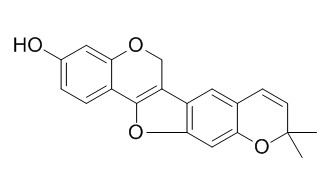Providing storage is as stated on the product vial and the vial is kept tightly sealed, the product can be stored for up to
24 months(2-8C).
Wherever possible, you should prepare and use solutions on the same day. However, if you need to make up stock solutions in advance, we recommend that you store the solution as aliquots in tightly sealed vials at -20C. Generally, these will be useable for up to two weeks. Before use, and prior to opening the vial we recommend that you allow your product to equilibrate to room temperature for at least 1 hour.
Need more advice on solubility, usage and handling? Please email to: service@chemfaces.com
The packaging of the product may have turned upside down during transportation, resulting in the natural compounds adhering to the neck or cap of the vial. take the vial out of its packaging and gently shake to let the compounds fall to the bottom of the vial. for liquid products, centrifuge at 200-500 RPM to gather the liquid at the bottom of the vial. try to avoid loss or contamination during handling.
J Inflamm (Lond). 2010 Sep 14;7:47.
Antioxidant activity of tuberosin isolated from Pueraria tuberose Linn[Reference:
WebLink]
METHODS AND RESULTS:
Pueraria tuberosa Linn (PT), Leguminosae (Fabaceae), known as Bidaarikand [6] is an extensive perennial climber, with palmately arranged leaves, blue colored flowers and half inches thick bark [7], growing throughout tropical parts of India, mostly in moist regions, monsoon forests and coastal tracts.
Its tuberous root, which is brown in color and slightly curved, is in clinical use for rejuvenation therapy. Its microscopic picture reveals the presence of prismatic calcium crystals and tanniniferous cells. It's major chemical constituents include flavones [C-glycoside (5,7,3',5'-tetrahydroxy-4'-methoxyflavone-3'-O-α-Lrhamnopyranosyl1→3-O-β-D-galactopyranoside)], Isoflavones (Puerarone), Coumstan (Tuberostan, Puerarostan) [8], Epoxychalcanol [Puetuberosanol], (3'-hydroxy-4'-phenoxy-α,β-epoxychalcan-α'ol)] [9], Pterocarpanoids [Hydroxytuberosin, Anhydroxytuberosin (3-O-methylAnhydrotuberosin)] [10], and Tuberosin [11].
CONCLUSIONS:
The powder of PT root-tubers are in clinical use as anti-aging and also as tonic, aphrodisiac, demulcent, lactagogue, purgative, cholagogue and also in scorpion sting. Besides, it is also useful in emaciation of children, debility and poor digestion [6,7]. Other investigators have reported it for skin care, as anti-fertility [12]. One of its phytochemical, purerin, has been associated with anti-diabetic property [13].



